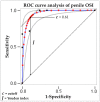Measurement of Oxidative Stress Index (OSI) in Penile Corpora Cavernosa and Peripheral Blood of Peyronie's Disease Patients: A Report of 49 Cases
- PMID: 38248858
- PMCID: PMC10821449
- DOI: 10.3390/metabo14010055
Measurement of Oxidative Stress Index (OSI) in Penile Corpora Cavernosa and Peripheral Blood of Peyronie's Disease Patients: A Report of 49 Cases
Abstract
Peyronie's disease (PD) is a chronic inflammatory disease affecting the penile albuginea. Oxidative stress (OS) is important for the development of the disease; therefore, it seemed interesting to us to directly measure OS at both the site of the disease and in peripheral blood. For a precise OS study, it is necessary to evaluate not only the single results of the total oxidant status (TOS) and total antioxidant status (TAS) but also their ratio: OS index (OSI) (arbitrary unit) = TOS/TAS × 100. This study included 49 PD patients examined and diagnosed in our Peyronie's care center and a control group of 50 cases. We collected blood samples from both the penis and a vein in the upper extremity; we used d-ROMs and PAT-test (FRAS kit) for OS measurement. Pearson's study found a statistical correlation between penile OSI values and PD plaque volumes: p-value = 0.002. No correlation was found between systemic OSI values and PD plaque volumes: p-value = 0.27. Penile OSI values were significantly reduced after the elimination of the PD plaque (p < 0.00001). The mean value of the penile OSI indices in the PD patients after plaque elimination corresponded to 0.090 ± 0.016 (p = 0.004). The comparison between the penile OSI values of the PD patients (with plaque elimination) and the control group revealed no statistically significant differences (p = 0.130). The absence of a correlation between Peyronie's plaque volume and systemic OSI values indicates that it is preferable to carry out the OS study by taking a sample directly from the site of the disease. By carrying out a penile OSI study, it would be possible to obtain a precise plaque-volume-dependent oxidative marker. Even if the study did not demonstrate any correlation between OSI indices and anxious-depressive state, we detected a high prevalence of anxiety (81.6%) and depression (59.1%) in PD patients.
Keywords: Peyronies’s disease; antioxidants; anxiety; depression; oxidative stress; oxidative stress index; reactive oxygen species (ROS); total antioxidant status; total oxidant status.
Conflict of interest statement
The authors declare no conflicts of interest.
Figures



Similar articles
-
Shaeer's Punch Technique: Transcorporeal Peyronie's Plaque Surgery and Penile Prosthesis Implantation.J Sex Med. 2020 Jul;17(7):1395-1399. doi: 10.1016/j.jsxm.2020.03.018. Epub 2020 May 7. J Sex Med. 2020. PMID: 32389586
-
Patients with Peyronie's disease achieve complete plaque regression after multimodal treatment with antioxidants: a case series.J Med Case Rep. 2022 Oct 8;16(1):359. doi: 10.1186/s13256-022-03614-1. J Med Case Rep. 2022. PMID: 36207748 Free PMC article.
-
Review of Management Options for Patients With Atypical Peyronie's Disease.Sex Med Rev. 2017 Apr;5(2):211-221. doi: 10.1016/j.sxmr.2016.07.004. Epub 2016 Aug 17. Sex Med Rev. 2017. PMID: 27544298 Review.
-
Electron microscopic study of the penile plaques and adjacent corpora cavernosa in Peyronie's disease.Int J Urol. 1997 May;4(3):274-8. doi: 10.1111/j.1442-2042.1997.tb00188.x. Int J Urol. 1997. PMID: 9255666
-
Inflammatory mechanisms and oxidative stress in Peyronie's disease: therapeutic "rationale" and related emerging treatment strategies.Inflamm Allergy Drug Targets. 2012 Feb;11(1):48-57. doi: 10.2174/187152812798889321. Inflamm Allergy Drug Targets. 2012. PMID: 22309083 Review.
References
-
- La Pera G., Pescatori E.S., Calabrese M., Boffini A., Colombo F., Andriani E., Natali A., Vaggi L., Catuogno C., Giustini M., et al. Peyronie’s disease: Prevalence and association with cigarette smoking. A multicenter population-based study in men aged 50–69 years. Eur. Urol. 2001;40:525–530. doi: 10.1159/000049830. - DOI - PubMed
LinkOut - more resources
Full Text Sources

